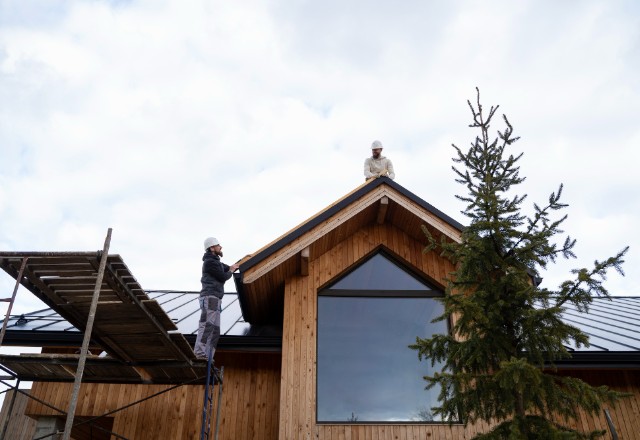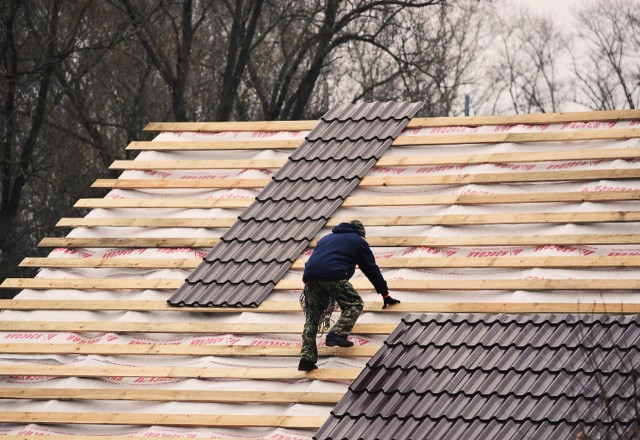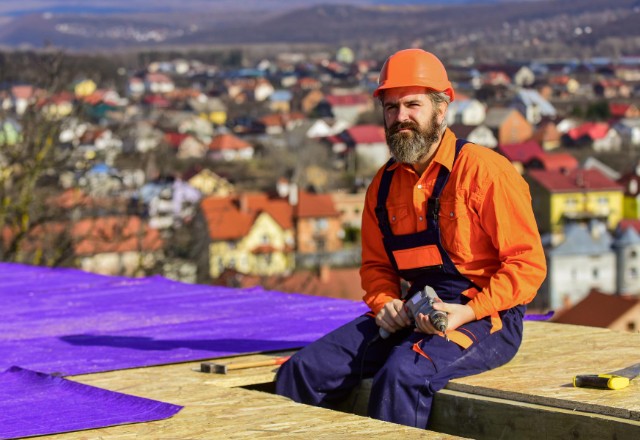Roofing refers to the process of installing, repairing, or replacing the roof of a building. It
involves working with various roofing materials and utilizing power tools to ensure the
stability, protection, and longevity of a structure. Roofing is an essential aspect of
construction, but it is also considered one of the most dangerous jobs within the industry.
The nature of the work, combined with the use of power tools and exposure to heights,
weather conditions, and electrical hazards, make roofing a high-risk occupation.
Disclaimer: The information provided in this article is for general informational purposes
only and should not be relied upon as legal advice. We recommend seeking professional assistance from a qualified lawyer or certified expert before engaging in any roofing
project. Furthermore, while we have taken reasonable measures to ensure the accuracy
of the information mentioned in this article, Advance Roofing LLC cannot guarantee its
accuracy or completeness. In addition, all readers are advised to consult a professional
for advice specific to your situation prior to taking any course of action related to roofing
projects. Advance Roofing LLC is always happy to help if you need our assistance!
Statistics on Roofing Injuries and Fatalities
Roofing is a dangerous job that poses numerous risks to workers. According to recent
statistics, roofing ranks high on the list of hazardous occupations in the construction
industry. Each year, a significant number of injuries and fatalities occur in this line of
work, which emphasize the need for safety measures and precautions.
The roofing industry witnesses a substantial number of injuries and fatalities annually.
These incidents are frequently severe and life-threatening. Falls from heights, contact
with power lines, and the improper use of power tools are among the leading causes of
accidents in this industry.
In the United States alone, the roofing industry experiences a high rate of fatalities.
Roofers face a fatal injury rate of about 45.2 deaths per 100,000 workers, which is
significantly higher than the average occupational fatality rate.
Moreover, statistics reveal that traumatic brain injuries, severe injuries, and fatal falls are
common among roofers. Heat exhaustion, slips on slippery surfaces, and exposure to
extreme weather conditions also contribute to the risks faced by workers in the roofing
industry.
Reasons for the Danger
Roofing is an inherently dangerous job due to the risks associated with working at
heights. The potential for serious injury or even fatality makes it crucial for workers to
prioritize safety on the job.
- One of the primary reasons roofing is dangerous is the risk of falls.
Working on rooftops without proper safety measures in place can lead to
fatal accidents. Without the use of safety harnesses, personal fall arrest
systems, or safety nets, workers are vulnerable to injuries from falls. Additionally, inadequate protective equipment further contributes to the
danger of roofing. Without proper safety gear, such as safety glasses or helmets, roofers are at risk of eye injuries or head trauma from falling
objects or debris.- Lack of safety measures and training also play a significant role in the
danger of roofing. When workers are not properly trained on safety
protocols or fail to follow industry guidelines, they increase the risk of
injury. This includes not conducting proper roof inspections, using
unstable ladders, or working on slippery surfaces.
Types of Hazards
Roofing is a challenging and hazardous job that comes with various types of hazards.
From the risk of falls to the dangers associated with the use of power tools and exposure
to electrical hazards, roofers face a wide range of potential dangers on a daily basis. In
this section, we will explore some of the most common hazards that roofers encounter
and discuss safety measures that can be implemented to mitigate these risks. By
understanding the types of hazards involved in roofing and following proper safety
procedures, workers can help ensure their own well-being and the safety of those around
them.

Slippery Surfaces
Working on slippery surfaces is one of the main hazards that roofers face in their line of
work. It is important to be aware of the risks and take necessary precautions to stay safe.
Moisture from various sources such as rain, ice, snow, and humidity can create slippery
surfaces, particularly on steep roofs. This significantly heightens the risk of slips, falls,
and potentially severe injuries. The combination of wet surfaces and the incline of the
roof creates a hazardous environment that requires extra attention and caution.
To mitigate the risks of working on slippery surfaces, it is crucial to have the right
equipment and take the necessary preventative measures. Wearing proper footwear with
good traction is essential to maintain stability and grip. Additionally, using roof jacks or
anchors can help secure yourself and prevent accidental slips or falls.
Roofing professionals should also closely monitor weather conditions and plan their work
accordingly. Avoiding work during heavy rainfall or when the roof is covered in ice or
snow is important to maintain safety. Taking breaks when surfaces become too slippery
or dangerous is crucial to prevent accidents.
Electrical Hazards
Roofing can pose significant electrical hazards that, if not properly addressed, can lead to
severe injuries or even fatalities.
- One of the main hazards is working near power lines. The close
proximity to overhead power lines increases the risk of electric shock or
electrocution. It is crucial for roofing professionals to maintain a safe
distance from any power lines and to be aware of their location when
working on a roof. - Another electrical hazard is working with or near electrical wiring.
Roofers must exercise caution and ensure that they do not accidentally
come into contact with live wires. This includes avoiding contact with
hot wires to prevent electric shocks.
Using non-conductive ladders and tools is an important safety precaution when working
around electricity. Non-conductive materials, such as fiberglass, do not conduct
electricity and can help prevent electrical shocks. Roofers should also be cautious when
working with metal objects, as they can conduct electricity and pose an additional risk.
If it is not possible to avoid working near power lines, contacting the utility company for
guidance is essential. They can help ensure that the necessary safety precautions are
taken to protect the roofing professionals and prevent any accidents.
Heat Exhaustion/Dehydration
Roofers face significant risks of heat exhaustion and dehydration while working on
rooftops, especially during the summer months or in areas with extreme temperatures.
The lack of shade or cover on the roof exposes them to direct sunlight and intense heat,
making it challenging to regulate their body temperature.
Extreme temperatures combined with physical exertion can lead to heat exhaustion, a
serious condition characterized by symptoms such as dizziness, nausea, rapid heartbeat,
and profuse sweating. If left untreated, heat exhaustion can progress to heat stroke, a
potentially life-threatening condition.
To prevent heat exhaustion and dehydration, it is crucial for roofers to stay hydrated
throughout the workday. They should drink smaller amounts of water frequently rather
than gulping down large quantities at once. Employers should provide water coolers or
water bottles for employees and encourage regular breaks in shaded areas to rest and
rehydrate.
In addition to staying hydrated, roofers should wear lightweight, breathable clothing to
help regulate their body temperature. Applying sunscreen and wearing wide-brimmed
hats can provide protection against the sun’s harmful rays. By implementing these
preventative measures, employers can ensure the safety and well-being of their roofing
professionals, minimizing the risk of heat-related illnesses.
Falling Objects
Falling objects pose a significant hazard in roofing jobs, posing risks to both roofers and
individuals on the ground. This danger arises from roofing materials, construction
equipment, and debris that can inadvertently fall from roofs.
The potential injuries and fatalities resulting from falling objects in roofing jobs can be
severe.
- Roofing materials such as shingles, tiles, or metal sheets can cause
blunt force trauma upon impact, potentially leading to broken bones,
concussions, or internal injuries. - Construction equipment, including power tools or machinery, can also
cause serious harm when they fall from heights, increasing the risk of
lacerations, fractures, or even amputations. - Furthermore, debris like loose nails, screws, or insulation materials can
become projectiles when they fall, potentially causing injuries to workers
or bystanders. - Even smaller objects can cause harm when dropped from heights due to
their gain in velocity.
To mitigate the risks associated with falling objects, proper safety measures must be
implemented. This includes providing workers with personal protective equipment, such
as hard hats and safety glasses, to reduce the risk of head and eye injuries. Additionally,
all materials and equipment should be securely fastened and stored when not in use to
prevent accidental falls. Regular inspections of the work area should be conducted to
identify and address any potential hazards promptly.

Risk of Injury from Falls
Roofing work poses significant risks of injury due to falls from a height. Roofers can fall
from roofs, scaffolding, ladders, or other elevated surfaces, greatly increasing the
likelihood of severe accidents. These falls can result in fatal injuries or permanent bodily
harm.
When roofers fall from a roof, they are exposed to the potential dangers of landing on
hard surfaces such as concrete or uneven terrain. The impact can cause fractures, spinal
cord injuries, or even death. Falls from scaffolding or ladders also pose similar risks.
Additionally, equipment failures such as ladder collapse or scaffold malfunctions can
contribute to fall hazards.
The consequences of falls in construction sites can be devastating. Fatal injuries not only
result in the loss of life but also have a profound impact on families and communities.
Permanent bodily harm, such as traumatic brain injuries or spinal cord damage, can lead
to lifelong disabilities, affecting the quality of life for the injured workers.
To prevent falls and mitigate these risks, proper safety protocols must be followed. This
includes using appropriate fall protection systems like safety harnesses, guardrails, or
safety nets. Regular inspections of equipment and structures should be conducted to
identify and address any potential failures that may contribute to fall hazards. By
prioritizing safety measures, roofing companies can protect their workers and prevent
tragic accidents on construction sites.
Preventative Measures to Take Before Starting Work on a Roof
Before beginning any roofing work, it is crucial to prioritize safety and take preventative
measures to minimize potential hazards. The construction industry, especially roofing,
can be inherently dangerous, exposing workers to various risks such as falls, electrical
hazards, and extreme weather conditions. However, with proper safety equipment,
training, and adherence to safety protocols, many accidents and injuries can be
prevented.
Some essential preventative measures include wearing the appropriate personal
protective equipment (PPE) like safety harnesses and safety glasses, conducting
thorough roof inspections to identify potential hazards, ensuring proper safety equipment
is in place, such as safety ropes and nets, and working on stable and level surfaces. By
implementing these preventative measures, roofers can significantly reduce the risk of
accidents and create a safer work environment. It is crucial for both employers and
employees to prioritize safety and follow guidelines set by the Occupational Safety and
Health Administration (OSHA) to ensure that the roofing industry remains a safe and
productive one.

Proper Safety Equipment
Roofing can be a dangerous job, but wearing the proper safety equipment is essential for
safeguarding against potential hazards. The right protective gear can significantly reduce
the risk of injuries and even fatal accidents in the roofing industry.
- Hardhats are a crucial piece of safety equipment that protect roofers
from falling objects and impacts. - Safety glasses shield the eyes from flying debris and dust particles.
- Hearing protection is necessary when working with power tools and
compressed air, which generate high noise levels that can be damaging
to hearing over time. - Respiratory masks or respirators may be required when handling
hazardous substances like asbestos or when working in dusty
environments, ensuring the inhalation of clean air. - In addition to these essentials, safety harnesses and personal fall arrest
systems are vital when working at heights. These devices prevent fatal
falls by securing the roofer to an anchor point. - Safety ropes and safety nets can also be used as secondary protective
measures.
Personal Fall Arrest System (PFAS) or Safety Harnesses
A Personal Fall Arrest System (PFAS) or Safety Harness is a crucial component of worker
safety when working on a roof. It is designed to prevent fatal falls and ensure worker
safety at heights. A PFAS consists of several key components:
- Anchor Point: The anchor point is a secure attachment point on the roof structure or a
lifeline system that is capable of supporting the weight of a worker in the event of a fall. It
is essential to ensure that the anchor point is strong and stable. - Full-Body Harness: A full-body harness is worn by the worker and distributes the force
of a fall throughout the body. It includes straps that go over the shoulders, around the
waist, and between the legs to provide maximum support and stability. Lifeline: The lifeline is a rope or cable that connects the worker’s harness to the anchor
point. It is typically made of durable and high-strength material to withstand the force of a fall. The lifeline acts as a connection between the worker and the anchor point.- Rope Grab: A rope grab is a device that moves freely along the lifeline but locks onto
the line in the event of a fall. It allows the worker to move along the lifeline while
maintaining a secure connection. - Lanyard: A lanyard is a flexible line that connects the worker’s harness to the rope grab
or another attachment point. It is adjustable and allows the worker to move freely while
still providing a measure of fall protection.
Each component of a PFAS is essential in ensuring worker safety while working on a roof.
The anchor point provides a secure attachment, the full-body harness distributes force,
the lifeline connects the worker to the anchor point, the rope grab locks in the event of a
fall, and the lanyard allows for movement while maintaining protection. Together, these
components form a comprehensive safety system that significantly reduces the risk of
falls and protects workers from serious injury or even death.

Conclusion
In conclusion, implementing proper safety measures and procedures in the roofing
industry is of paramount importance. Roofers face numerous potential risks and hazards
on a daily basis, including falls, electrical hazards, and heat exhaustion. By prioritizing
safety, companies can protect their workers from fatal accidents and severe injuries.
Roofing companies must prioritize safety by providing comprehensive training, enforcing
safety protocols, and ensuring the availability of proper safety equipment. By doing so,
they can protect their workers and prevent accidents, ultimately contributing to a safer
roofing industry.



 509-201-4190
509-201-4190
